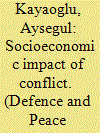| Srl | Item |
| 1 |
ID:
168347


|
|
|
|
|
| Summary/Abstract |
The industrial pollution caused by China's unprecedent economic expansion seriously imperils public health, giving rise to public's high demand for better environmental quality. The paper employs the difference-in-differences (DID) methodology to conduct a quasi-natural experiment based on the Pollution Information Transparency Index (PITI) to evaluate the public participation impact on pollution emissions reduction and environment technology efficiency. The results show that PITI information disclosure has a positive influence on pollution emissions reduction, however, some existing literatures may overstate the effect of public participation on environment improvement in China, the empirical results show that government administrative measures still play essential role at current stage. The paper also finds that the influence of public participation exists in eastern China rather than in central and western China. In addition, the results of using environment technology efficiency as outcome variable show insignificant effect, but eastern China has positive environment technology efficiency, suggesting that economic development may increase enterprise technological input, hence achieving mutually beneficial achievements of economy and ecological efficiency.
|
|
|
|
|
|
|
|
|
|
|
|
|
|
|
|
| 2 |
ID:
143603


|
|
|
|
|
| Summary/Abstract |
Uprising tensions during 2010 in eastern and southeastern regions of Turkey provoked arguments about the necessity for a State of Emergency (SOE; ‘Olağanüstü Hal’ in Turkish) declaration in those regions, with a belief of enduring political sustainability. The discussion is inflamed by a speech of the Nationalist Movement Party’s leader about the suggestion to announce a SOE ruling after the death of 24 Turkish soldiers in Hakkari (a city in the southeast of Turkey) in an attack of the PKK (Kurdistan Workers’ Party) on the 19 October 2011. Although a new announcement of SOE did not take place, the discussion itself induced the idea behind this paper which is to provide a quantitative analysis of the SOE in Turkey. In fact, the SOE ruling is not a new concept for Turkey and it has been implemented in 13 cities in the eastern and southeastern regions from 1987 to 2002. Although there have been many discussions about the costs of these 15 years of the SOE ruling in terms of military expenditure and, thus, on the national budget, there is a lack of quantitative analytical examination of the economic and social costs of it. Difference-in-differences analysis reveals negative spillover impacts of the SOE, especially on the forced migration, unemployment, and educational investments. The results also show that SOE ruling is an important factor for the underdevelopment of the eastern and southeastern regions in Turkey and, thus, a new SOE will bring enormous inequalities, both economically and socially, and an intensification of the ethnic tensions in Turkey.
|
|
|
|
|
|
|
|
|
|
|
|
|
|
|
|